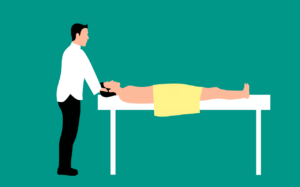
Have you ever woken up with a stiff neck or sore shoulders after a night’s sleep? If so, you’re not alone. Neck and shoulder pain while sleeping is a common issue that many people struggle with. However, there are simple and effective ways to alleviate this discomfort and wake up feeling refreshed. In this article, we will explore practical tips and strategies to help you find relief and improve the quality of your sleep. By making a few adjustments to your sleeping position, investing in the right pillow, and incorporating some relaxation techniques, you can say goodbye to those nagging aches and wake up feeling rejuvenated each morning. So, let’s dive into the secrets of relieving neck and shoulder pain while sleeping!
Understanding Neck and Shoulder Pain
Neck and shoulder pain can be a common and frustrating issue that affects many people. The discomfort can range from mild to severe and impact your daily activities, including your ability to get a good night’s sleep. In order to address this problem and find relief, it’s important to understand the causes of neck and shoulder pain and how it can affect your sleep quality.

Causes of Neck and Shoulder Pain
There are various factors that can contribute to neck and shoulder pain. Poor posture, such as slouching or hunching over a desk, can put strain on the muscles and joints in the neck and shoulders. Holding your head in an awkward position for an extended period of time, such as when using a phone or tablet, can also lead to discomfort. Additionally, injuries, such as whiplash or muscle strains, can cause acute pain in these areas.
Another common cause of neck and shoulder pain is tension and stress. When you are stressed or anxious, your muscles tend to tense up, and this can result in pain and stiffness. Sleeping in an uncomfortable position or using an unsupportive pillow or mattress can exacerbate these issues and contribute to ongoing pain.
Effects of Neck and Shoulder Pain on Sleep Quality
Neck and shoulder pain can have a significant impact on your ability to sleep well. The discomfort can make it difficult to find a comfortable position and may lead to tossing and turning throughout the night. This constant movement can disrupt your sleep cycle and prevent you from reaching deep, restorative sleep stages.
Furthermore, the pain can also cause you to wake up frequently during the night. These interrupted sleep patterns can leave you feeling groggy and fatigued during the day, affecting your overall well-being and productivity. It’s important to address neck and shoulder pain in order to improve your sleep quality and promote better overall health.
Choosing the Right Pillow
One of the key factors in relieving neck and shoulder pain while sleeping is choosing the right pillow. A supportive pillow can help maintain the natural alignment of your neck and spine, reducing stress on the muscles and preventing discomfort.
Importance of Pillow Support
Having proper support for your neck and shoulders is crucial when it comes to alleviating pain. A pillow that is too soft may not provide enough support, leading to improper alignment and increased strain on the muscles. On the other hand, a pillow that is too firm may cause excessive pressure and discomfort. Finding a pillow that strikes the right balance in terms of support and comfort is essential.
Considerations for Pillow Height
The height of your pillow also plays a role in preventing neck and shoulder pain. The ideal pillow height will depend on your sleeping position and personal preferences. For back sleepers, a pillow with medium thickness that supports the natural curve of the neck is recommended. Side sleepers may benefit from a slightly higher pillow to maintain proper alignment between the head, neck, and shoulders. Stomach sleepers, however, should avoid using high pillows as this can strain the neck and restrict breathing.
Types of Pillows Recommended for Neck and Shoulder Pain
There are several types of pillows that are specifically designed to alleviate neck and shoulder pain. Memory foam pillows contour to the shape of your head and neck, providing customized support and relieving pressure points. These pillows are also known for their ability to retain their shape and offer durability.
Another option is a cervical pillow, which has a curved design that supports the natural curve of your neck. This type of pillow helps to maintain proper alignment and reduce strain on the muscles. Water-filled pillows are also popular as they can be adjusted to your desired firmness and provide gentle support.
Optimizing Sleep Positions
In addition to choosing the right pillow, optimizing your sleep positions can greatly help in relieving neck and shoulder pain. Proper alignment of your body during sleep can alleviate strain on the muscles and promote better sleep quality.
Back Sleeping Posture
Sleeping on your back is generally considered to be the best position for spinal alignment. To optimize your back sleeping posture, place a pillow under your knees to maintain a natural curve in your lower back. This position helps alleviate pressure on the neck and shoulders and reduces the risk of developing pain or stiffness.
Side Sleeping Posture
If you prefer to sleep on your side, it’s important to ensure that your body maintains proper alignment. Place a pillow between your knees to keep your hips and spine in alignment. Additionally, use a supportive pillow that fills the gap between your neck and the mattress, keeping your head and neck in a neutral position.
Stomach Sleeping Precautions
Sleeping on your stomach can be challenging when it comes to maintaining proper alignment of the neck and shoulders. This position tends to strain the neck and put pressure on the spine. If you find it difficult to switch to a different sleep position, try using a thin pillow or no pillow at all to reduce strain on your neck.

Using a Specialized Neck Pillow
For specific neck and shoulder pain, a specialized neck pillow may provide the best support. These pillows are contoured to follow the natural curvature of the neck and provide targeted support. They can help relieve pressure on the muscles and alleviate discomfort. Experiment with different types of specialized neck pillows to find the one that suits your needs and preferences.
Maintaining Proper Body Alignment
In addition to optimizing your pillow and sleep positions, maintaining proper body alignment while sleeping is essential for reducing neck and shoulder pain. This can be achieved through the firmness and support of your mattress, as well as additional supports such as pillows or cushions.
Importance of Mattress Firmness
The firmness of your mattress plays a crucial role in ensuring proper body alignment during sleep. A mattress that is too soft may cause your body to sink in, leading to an unnatural curvature of the spine and increased strain on the neck and shoulder muscles. On the other hand, a mattress that is too firm may not provide adequate support and lead to discomfort. Finding a mattress with the right level of firmness for your body type and preferences can make a significant difference in alleviating pain.
Using a Supportive Mattress
Opting for a supportive mattress that promotes proper spinal alignment is essential for reducing neck and shoulder pain. Look for a mattress that has adequate support for your body and distributes weight evenly. Memory foam and latex mattresses are often recommended for their ability to contour to your body shape and provide targeted support.
Using Additional Supports Like Pillows or Cushions
In some cases, additional supports like pillows or cushions can help maintain proper body alignment while sleeping. Placing a pillow under your knees when sleeping on your back can help alleviate pressure on the lower back and reduce strain on the neck and shoulders. Similarly, using a cushion to support the natural curves of your body while sleeping on your side can help prevent misalignment.
Stretching and Exercising Before Bed
Stretching and exercising before bed can be an effective way to relieve tension in the neck and shoulder muscles, promoting relaxation and reducing pain. Incorporating these activities into your nighttime routine can help prepare your body for sleep.

Recommended Neck and Shoulder Stretches
Performing gentle stretches specifically targeting the neck and shoulder muscles can help alleviate pain and tension. Some recommended stretches include neck rotations, where you slowly turn your head in each direction, and shoulder rolls, where you relax your shoulders and roll them forwards and backwards.
Shoulder Blade Squeezes
To release tension in your shoulders and upper back, try shoulder blade squeezes. Sit or stand with your arms relaxed at your sides, then gently squeeze your shoulder blades together and hold the position for a few seconds. Repeat this exercise several times to help relax the muscles and improve circulation.
Upper Back Stretches
Stretching the upper back can also contribute to relieving neck and shoulder pain. One effective stretch is the upper back extension. Stand with your feet shoulder-width apart, place your hands on your lower back, and gently arch backward, looking up slightly. Hold this position for a few seconds and repeat as needed.
Neck Exercises to Relieve Tension
Simple neck exercises can help target the muscles responsible for neck pain and tension. One example is the neck tilt, where you slowly tilt your head to one side, bringing your ear closer to your shoulder. Hold this position for a few seconds and repeat on the other side. Another exercise is neck rotations, where you slowly turn your head from side to side. These exercises can help improve flexibility and reduce discomfort in the neck and shoulders.
Relaxation Techniques
Engaging in relaxation techniques before bed can help calm your mind and body, promoting better sleep and alleviating neck and shoulder pain. These techniques can help reduce muscle tension and promote a sense of calm and relaxation.

Deep Breathing Exercises
Deep breathing exercises are a simple and effective way to relax both the mind and body. Find a quiet and comfortable place to sit or lie down, close your eyes, and take slow, deep breaths. Inhale deeply through your nose, filling your belly with air, and exhale slowly through your mouth. Focus on your breath and the sensations as you inhale and exhale, allowing your body to relax with each breath.
Progressive Muscle Relaxation
Progressive muscle relaxation involves tensing and relaxing different muscle groups throughout your body. Start by tensing the muscles in your toes for a few seconds, then release and let them relax. Gradually work your way up through each muscle group, including your legs, abdomen, arms, shoulders, and face. By consciously tensing and then relaxing each muscle group, you can promote a deep state of relaxation.
Meditation and Mindfulness Practices
Meditation and mindfulness practices can help calm the mind and reduce stress and tension in the body. Find a quiet and comfortable place, sit or lie down, and focus your attention on the present moment. You can choose to concentrate on your breath, a specific object, or simply observe your thoughts and emotions without judgment. Regular meditation and mindfulness practice can help reduce overall stress and promote better sleep quality.
Heat and Cold Therapy
Heat and cold therapy are commonly used to relieve muscle pain and reduce inflammation. Applying heat or cold to the neck and shoulder area can help alleviate pain and promote relaxation.
Using Heat Packs or Warm Compresses
Applying heat packs or warm compresses to the neck and shoulders can help increase blood flow and relax tense muscles. Heat therapy can also help reduce stiffness and alleviate pain. You can use a hot water bottle, a heating pad, or take a warm shower or bath before bedtime to relax the muscles and prepare for sleep.

Benefits of Applying Heat
Heat therapy has several benefits when it comes to relieving neck and shoulder pain. The warmth helps increase blood flow to the area, which can promote healing and reduce muscle tension. Heat therapy also helps to relax and soothe the muscles, providing a sense of comfort and relief. Incorporating heat therapy into your bedtime routine can help you unwind and prepare for a restful night’s sleep.
Using Cold Packs or Ice Packs
Applying cold packs or ice packs to the neck and shoulders can help reduce inflammation and numb pain. Cold therapy constricts blood vessels, which can assist in reducing swelling and minimizing discomfort. Wrap an ice pack or a bag of frozen peas in a cloth and apply it to the affected area for about 15 minutes. Be sure to take breaks between applications to prevent skin damage.
Benefits of Cold Therapy
Cold therapy is particularly beneficial for acute pain or injuries, as it helps reduce inflammation and numb the area, providing immediate relief. Using cold therapy before bed can help decrease swelling, reduce pain, and promote a more comfortable sleep.
Creating a Sleep-Friendly Environment
In order to optimize your sleep and alleviate neck and shoulder pain, it’s important to create a sleep-friendly environment. Several factors, such as the darkness and quietness of the room, as well as temperature and humidity levels, can significantly impact your sleep quality.
Importance of a Dark and Quiet Room
A dark and quiet room promotes better sleep by minimizing distractions and creating a peaceful atmosphere. Use blackout curtains or blinds to block out external light sources that can interfere with your sleep. Additionally, consider using earplugs or a white noise machine to drown out any unwanted noise.
Controlling Temperature and Humidity
Maintaining a comfortable temperature and humidity level in your bedroom can greatly contribute to quality sleep. The ideal temperature for most people falls between 60 and 67 degrees Fahrenheit. Adjust your thermostat or use a fan or air conditioner to achieve a cool and comfortable sleep environment. Additionally, consider using a humidifier or dehumidifier to control humidity levels and prevent dryness or excessive moisture in the air.
Using Aromatherapy for Relaxation
Aromatherapy involves the use of essential oils to promote relaxation and improve sleep quality. Lavender, chamomile, and ylang-ylang are known for their calming properties and can help reduce anxiety and promote a sense of tranquility. You can use a diffuser to disperse the scent in your bedroom or apply a few drops of essential oil to your pillow or bedding.
Sleeping Posture Adjustments
Making simple adjustments to your sleeping posture can go a long way in relieving neck and shoulder pain. Ensuring proper alignment of your neck and shoulders is crucial to reducing strain and discomfort.
Using a Rolled Towel or Small Cushion
Placing a rolled towel or small cushion under your neck or shoulder can provide additional support and help align your spine. This can be especially beneficial if you sleep on your back or side. Experiment with different placements and thicknesses to find the most comfortable and supportive position for your needs.
Proper Alignment of Neck and Shoulders
It’s important to maintain proper alignment of your neck and shoulders while sleeping. Whether you sleep on your back or side, make sure your head and neck are in a neutral position, not tilted or twisted. Avoid using excessively high pillows that can cause your head to be tilted forward or raised too high, placing strain on the neck and shoulders.
Avoiding Excessive Pillow Height
Using excessively high pillows can lead to unnatural positioning of the neck and shoulders, resulting in pain and discomfort. Opt for a pillow that provides adequate support without raising your head too high. Finding the right pillow height for your body and preferred sleep position is crucial for maintaining proper alignment and relieving neck and shoulder pain.
Consulting with a Healthcare Professional
If you have been experiencing persistent neck and shoulder pain that affects your sleep quality, it’s important to consult with a healthcare professional. They can assess your symptoms, identify any underlying conditions, and recommend appropriate treatment options and therapies.
When to Seek Medical Advice
While occasional neck and shoulder pain may not be cause for concern, persistent or worsening pain should not be ignored. If you are experiencing severe pain, numbness, tingling, or weakness in your arms or hands, it’s important to seek medical advice. Additionally, if your pain is associated with other symptoms such as headaches or difficulty sleeping, it’s advisable to consult with a healthcare professional.
Possible Underlying Conditions
There are various underlying conditions that can contribute to neck and shoulder pain. These may include degenerative disc disease, herniated discs, osteoarthritis, or muscle imbalances. Identifying any underlying conditions is important in order to develop an effective treatment plan and prevent further complications.
Treatment Options and Therapy
The appropriate treatment options and therapy for neck and shoulder pain will depend on the underlying cause and severity of your symptoms. Your healthcare professional may recommend physical therapy to help strengthen and stretch the affected muscles, as well as pain medication or muscle relaxants to alleviate discomfort. In some cases, injections or surgery may be necessary to address more severe conditions.
Remember, it’s always important to consult with a healthcare professional to determine the best course of action for your specific situation. They can provide personalized advice and recommend the most suitable treatment options to alleviate your neck and shoulder pain and improve your sleep quality.







